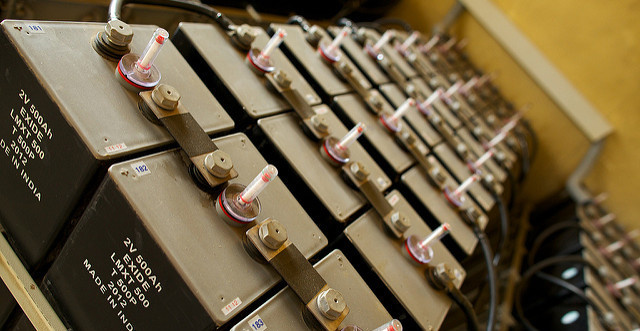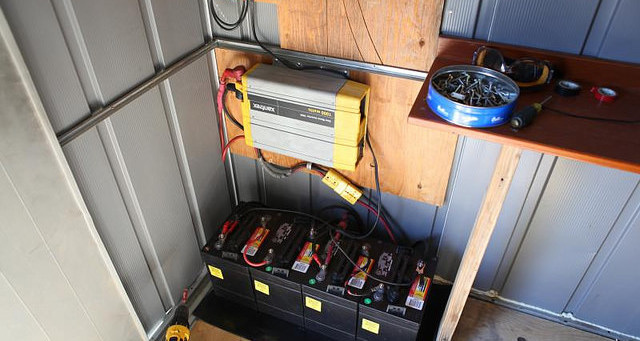How to Make a DIY Battery Bank for Your Solar Panels

Thinking about installing batteries to go with your solar panels? No matter if it’s an off-grid mountain cabin or a battery back-up for your grid-connected homes, the basic process for planning designing your own DIY battery bank is fairly straightforward, but can be a bit confusing your first time around.
Below are the basic steps to planning and designing your own DIY battery bank to complement your solar installation. To make the planning process a bit easier to understand, we’ve included a running example throughout the article. Simply find the italics throughout each section to follow-along!
Use the information below as a starting point, but when the time comes to really start planning your DIY battery bank, be sure to check out a few books on the subject at your local library, browse relevant online articles and videos, and join a couple online forums for guidance and help with any questions you have!
Calculate Your Load

The first step in designing your DIY battery bank is calculating how much electricity you typically use -known as your electricity load. There are two methods to calculate your load:
- First, you can look at your previous electricity usage. If you are already connected to the grid, simply look at your total electricity use for the last 12 months and divide by 365 to get your daily average.
- If you aren’t connected to the grid, you probably don’t have any data on your previous energy use. In this case, you’ll need to calculate how much electricity you need by adding up the wattage of all the electrical devices in the home and estimating how many hours you’ll use them each day.
For example:
- 5 LED light bulbs*8 watts (the wattage of each light bulb)*3 hours per day = 120 watt-hours/day
- 1500 watt blender*.05 hours per day = 75 watt-hours/day (I can’t go without my morning smoothies!)
- 50 watt laptop*6 hours per day = 300 watt-hours/day
As you can imagine, this process takes time and there are a lot of numbers to keep track of, so be sure not to rush this step! The size of your entire battery bank will be based on these calculations, so you need to make sure they are as accurate as possible!
To help you keep track, use a spreadsheet like Microsoft Excel or Google Spreadsheets (which is free with Gmail!). There are also many online tools to help you in this process, including calculators from websites like Wholesale Solar and Affordable Solar.
Example: Let’s say we have a small off-grid mountain cabin. The space heater, water heater, and stove are propane, so only a few key items need electricity. Along with the LEDs, blender, and laptop above, we’ll also have to power our cell phone, fans, TV, and clothes washer. Our usage probably looks something like this:
| Item | Amount of Items | Wattage | Hours per Day | Total Daily kWh Use |
| LED Light Bulbs | 5 | 8 | 3 | .12 |
| Blender | 1 | 1500 | .05 | .075 |
| Laptop | 1 | 50 | 6 | .30 |
| Cell Phone | 1 | 3.5 | 8 | .028 |
| Fans | 2 | 50 | 3 | .30 |
| TV | 1 | 100 | 1 | .10 |
| Clothes Washer | 1 | 600 | .50 | .30 |
| Total | 2,312 | 1.22 kWh |
Our total load for each day is 1.22 kWh and about 36.6 kWh a month. Just to note, this is a VERY small cabin with only a few electrical appliances! For reference, the average kWh usage per month for grid-connected homes in the US is 900 kWh!
Amount of Back-up Power and Depth of Discharge

Batteries allow you to store the electricity your solar installation generates for later use, and after you find your daily electrical load, you need to decide how many days of backup power you want. Most homeowners choose between 1 and 4 days, though this depends on your needs and weather.
Example: We’ll choose 3 days of back-up power, meaning our battery system needs to provide at least 3.66 kWh (1.22 kWh per day multiplied by 3 days) for those days when it’s rainy or cloudy.
To make the process a little more confusing: battery capacity is measured in amp-hours – not watt-hours or kilowatt-hours like the electricity generated by your solar installation. Lucky for us, finding amp-hours is easy! Simply divide watt-hours by the voltage of the solar installation. Off-grid solar installations can be 12 volt, 24 volt, or 48 volt – the voltage you choose depends on your installation’s size, location and layout, and needs.
Example: Our small installation will be 12 volts, meaning we need a battery with 305 amp-hours.
(3660 watt-hours/12 volts = 305 amp-hours)
305 amp-hours. Easy, right?
Hold on though, there’s one more step. If you discharge the batteries down to their full capacity, you can hinder their ability to fully charge in the future. Because of this, battery manufacturers recommend only using a portion of the available battery, usually only 25% to 50% for lead-acid batteries (the most common type of battery for solar). Of course, only using a small fraction of your batteries’ power is annoying, but just consider all the batteries an investment. If you only discharge your batteries down to 25% or 50%, they’ll provide you with years of reliable service.
Related: Tesla Powerwall II Battery Pack Review
We’ve decided that we’re only going to discharge about 40% of our batteries’ capacity, so we need to divide our battery size by .4 to account for this: 305 amp-hours*.4 = 763 amp-hours.
So, our batteries need to be 12 volts and have capacity of at least 763 amp-hours.
Connecting Batteries in Parallel vs in Series
Now that you know the voltage of your installation and the battery capacity you need, it’s almost time to start looking at batteries! In your battery system, there are two ways to connect multiple batteries together – in parallel or in series:
- In Parallel: Connecting batteries in parallel simply means that each battery’s positive terminal is connected to the next battery’s positive terminal (and each negative terminal is connected to the next negative terminal). Batteries that are connected in parallel add up all their amp-hours together, allowing you to increase the total capacity of your battery bank.
- In Series: Connecting batteries in series means connecting the positive terminal of the first battery to the negative terminal of the next, and so on. When connecting in series, amp-hours don’t increase, but voltage adds up amongst all the batteries. It’s also possible to create a system where batteries are connected both in parallel and in series to both increase voltage and amp-hours!
We need 768 amp-hours for our 12 volt solar installation. If we connect in parallel, we could have two 12-volt 400 amp-hour batteries, giving us 800 amp-hours but keeping our 12 volt system. If we connect in series, we could have 2 6-volt 800 amp-hour, giving us a 12 volt battery system with 800 amp-hour capacity. Whether to connect in series or in parallel is a matter of what batteries are available and the structure of your solar and storage installation.
All this can be confusing, but just remember: connecting in parallel adds amp-hours; connecting in series adds voltage! Knowing what options are available to you will help you build the most cost-effective installation that suits your needs.
Size Your Inverter

Inverters are an integral part of any solar and storage installation, as they convert the direct current (DC) electricity produced by your solar panels and housed in the batteries to alternating current (AC) required by all our electronic devices.
Inverters convert electricity from DC to AC in real time. Inverters have no storage capacity – as your devices use electricity, that electricity flows from the batteries through the inverter to the device. Because of this, your inverter needs to be large enough to handle the biggest load you’ll put on it at any single instance.
The easiest way to calculate this is to add up the wattage of all your devices that could be operating at the same time.
Let’s say we’re very busy in our cabin, so it’s possible that all our electrical devices could be going at the same time. As you can see from the table above, the total wattage for all my devices is 2,312 watts. So I need an inverter that can continuously handle at least 2,312 watts.
There’s one more critical step though to sizing your inverter. Some electric devices, especially motor-driven devices like refrigerators, power tools, and air conditioners, draw 2 to 8 times the amount of power they typically use just to turn on! This huge power draw is known as the surge load and you need to account for this when choosing an inverter.
Unlike a device’s typical wattage, which is printed on the back of a device, manufacturers don’t publish the surge load of their devices, so you either need to contact them directly or measure the electrical pull yourself for your motor-driven devices.
Fortunately for us, inverter manufacturers these days account for surge loads and most inverters can handle high spikes of electricity in short bursts. When choosing an inverter, be sure that they can handle the surge load for any of the electrical equipment you use.
We know that we need an inverter that can continuously handle at least 2,312 watts, but let’s say our clothes washer uses 3x the amount of power just to turn on, so our surge load is 3,512 watts. We could simply buy an inverter that can handle 4000 watts – but that’s expensive and unnecessary. It just so happens that there’s a 2500 watt inverter that can handle a surge load of 5000 watts – more than enough for our needs!
